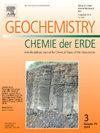Metamorphic evolution of south Indian granulites: New insights from in-situ U-Pb dating and Nd-Hf isotope fingerprinting of zircon, titanite, monazite, and apatite
IF 2.9
3区 地球科学
Q2 GEOCHEMISTRY & GEOPHYSICS
引用次数: 0
Abstract
The Precambrian Southern Granulite Terrane (SGT) of south India is well known for the preservation of high to ultrahigh-temperature granulite facies metamorphic rocks, with their formation linked to the assembly of the East Gondwana supercontinent. Although the timing and duration of this Himalayan-scale collisional orogeny is well characterized, the peak to post-peak evolutionary history of these granulitic rocks is poorly understood. This study attempts to characterize the peak to post-peak metamorphic evolutionary history of south Indian granulites using in-situ accessory mineral geochronology and isotopic fingerprinting of a metapyroxenite sample collected from the central part of SGT. U![]() Pb dating of zircon and monazite from the sample constrains the timing of peak metamorphism at 560–550 Ma, while the timing of fluid activity and cooling was characterized using titanite (557 ± 2 Ma) and apatite (410 ± 3 Ma) dating. U
Pb dating of zircon and monazite from the sample constrains the timing of peak metamorphism at 560–550 Ma, while the timing of fluid activity and cooling was characterized using titanite (557 ± 2 Ma) and apatite (410 ± 3 Ma) dating. U![]() Pb ages recovered from available accessory phases, together with temperature estimates from trace element thermometry and closure temperature estimates, suggest variable and slow cooling rates for the studied granulite. On the other hand, Hf
Pb ages recovered from available accessory phases, together with temperature estimates from trace element thermometry and closure temperature estimates, suggest variable and slow cooling rates for the studied granulite. On the other hand, Hf![]() Nd isotopic fingerprinting of zircon and titanite points to the involvement of slab-derived materials during peak metamorphism, providing new evidence for melt/fluid-assisted metamorphism in the area.
Nd isotopic fingerprinting of zircon and titanite points to the involvement of slab-derived materials during peak metamorphism, providing new evidence for melt/fluid-assisted metamorphism in the area.
南印度麻粒岩的变质演化:锆石、钛矿、独居石和磷灰石的原位U-Pb定年和Nd-Hf同位素指纹图谱的新见解
印度南部前寒武纪南麻粒岩地体(SGT)以保存高温至超高温麻粒岩相变质岩而闻名,其形成与东冈瓦纳超大陆的组合有关。尽管喜马拉雅碰撞造山运动的时间和持续时间有很好的特征,但这些粒质岩石的峰后演化历史却知之甚少。本研究试图通过现场辅助矿物年代学和同位素指纹分析来表征南印度麻粒岩的峰后变质演化史。样品中的锆石和单氮石的UPb定年限制了560-550 Ma的峰值变质时间,而流体活动和冷却的时间则用钛矿(557±2 Ma)和磷灰石(410±3 Ma)定年来表征。从可用的附属相中恢复的UPb年龄,以及从痕量元素测温和封闭温度估计中估计的温度,表明所研究的麻粒岩的冷却速率是可变的和缓慢的。另一方面,锆石和钛矿的HfNd同位素指纹图谱表明,在峰变质过程中存在板源物质的参与,为该区的熔融/流体辅助变质作用提供了新的证据。
本文章由计算机程序翻译,如有差异,请以英文原文为准。
求助全文
约1分钟内获得全文
求助全文
来源期刊

Chemie Der Erde-Geochemistry
地学-地球化学与地球物理
CiteScore
7.10
自引率
0.00%
发文量
40
审稿时长
3.0 months
期刊介绍:
GEOCHEMISTRY was founded as Chemie der Erde 1914 in Jena, and, hence, is one of the oldest journals for geochemistry-related topics.
GEOCHEMISTRY (formerly Chemie der Erde / Geochemistry) publishes original research papers, short communications, reviews of selected topics, and high-class invited review articles addressed at broad geosciences audience. Publications dealing with interdisciplinary questions are particularly welcome. Young scientists are especially encouraged to submit their work. Contributions will be published exclusively in English. The journal, through very personalized consultation and its worldwide distribution, offers entry into the world of international scientific communication, and promotes interdisciplinary discussion on chemical problems in a broad spectrum of geosciences.
The following topics are covered by the expertise of the members of the editorial board (see below):
-cosmochemistry, meteoritics-
igneous, metamorphic, and sedimentary petrology-
volcanology-
low & high temperature geochemistry-
experimental - theoretical - field related studies-
mineralogy - crystallography-
environmental geosciences-
archaeometry
 求助内容:
求助内容: 应助结果提醒方式:
应助结果提醒方式:


